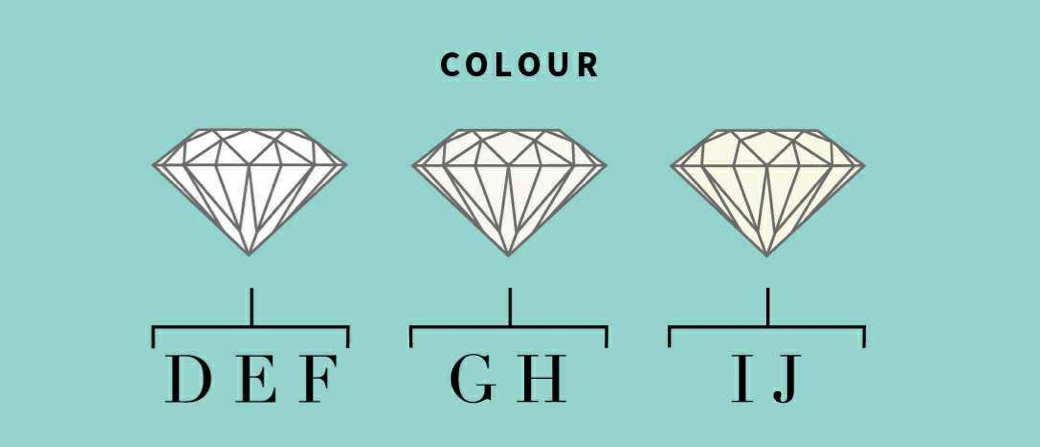

A diamond with the highest colour grade is the diamond with the least amount of colour. The highest grade is D, which indicates that a diamond is colourless, and therefore extremely rare and valuable. An E grade indicates minute traces of colour that can only be detected by an expert. An F grade indicates slight traces of colour. A diamond in the G-H range is near-colourless, with traces of yellow generally visible only when compared with whiter diamonds. I-J diamonds are also near-colourless, with colour slightly detectable to the unaided eye. K-M, diamonds begin to display noticeable colour.
Colour differences in diamonds are very subtle. They are therefore graded under controlled lighting conditions and are compared to a master set of diamonds for accuracy. Ask your retailer to show you a variety of colour grades next to one another to help you to recognize the differences. Although the presence of colour diminishes a diamond’s value and cost, a bright, intense yellow-coloured diamond is considered a "fancy" and is normally priced at a premium. Red, blue, pink, purple and green diamonds are also called fancies. They are rare and valuable.

The vast majority of diamonds contain some impurities, known as inclusions, which can detract from their beauty and impede light return. The size, number, type and location of these inclusions all factor into a diamond’s final clarity grade. The universal system for grading diamonds is the IF to I3 system.
F and IF F means internally and externally flawless. IF means internally flawless, a scratch on the surface of the diamond may need to be removed. F and IF diamonds are very rare and expensive.
VVS1 and VVS2 VVS means very, very slightly included. This means it is very difficult to see the impurities, even using a 10-power loupe. The numbers represent levels within this grade – VVS1s are cleaner than VVS2s.
VS1 and VS2 These diamonds are very slightly included, with impurities that are not visible to the unaided eye. VVS and VS diamonds are known as “eye-clean,” which means either a microscope or a 10-power loupe is necessary to see them.
SI1 and SI2 These diamonds are slightly included, which means the inclusions are visible under 10-power magnification and might be visible to the unaided eye. Sometimes, a diamond is graded SI1 even though it has no more inclusions than an VS2, but because those inclusions occur in the centre of the diamond, they are more noticeable and more likely to block light. Some inclusions can be hidden by a mounting, thus having little effect on the beauty of a diamond.
I1, I2 and I3 These diamonds contain visible inclusions.

Cut is often confused with shape. Shape refers to the overall outline of a diamond when viewed from the top. Examples include princess, emerald, marquise, oval, pear, heart and cushion. These are usually referred to as “fancy” shapes. The overwhelming majority of diamonds, however, are round, and the most common cut is the round brilliant. A diamond’s cut grade refers to the placement and proportions of facets in a round-brilliant diamond, measuring the extent to which they maximize brilliance (light return), scintillation (sparkle) and fire (flashes of colour).
There is no one single set of angles and proportions that constitute an ideal round-brilliant cut, but there are general parameters that dictate the quality of a diamond’s cut. Width and depth affect how light travels through a diamond and where it exits a diamond. The goal is to angle the facets in a way that causes them to refract light out through the top, or table, of a diamond. When a diamond is too shallow, light will exit through the bottom or pavilion. When a diamond is too deep, light will exit through the sides of the pavilion.
Polish and symmetry also affect the beauty of a diamond. Polish refers to the smoothness of the diamond’s facets. Symmetry refers to the alignment of the facets. Even with a good cut, poor symmetry can redirect light return, causing it to exit through the pavilion instead of the table. A poor polish can make a diamond appear dull and lifeless. Most larger diamonds are accompanied by a certificate that grades and describes a diamond’s cut, including separate grades for polish and symmetry. Why aren’t all diamonds cut to ideal proportions? To cut a diamond perfectly, a craftsman will often need to cut away more than 50% of the rough diamond, so there is usually a tradeoff between ideal cut and weight retention – the primary determinant of a diamond’s value.

Although it is important to consider clarity, colour and cut when purchasing a diamond, carat weight is the “C” most likely to determine a diamond’s value. Fortunately, it is the easiest characteristic to measure. The term carat is derivative of the word carob. Carob seeds are similar in weight to each other, so diamonds were originally measured by comparison – one carob seed equaled one carat. A carat is divided into 100 points. So a half-carat diamond is 50 points, and is expressed as 0.50ct. A one-and-three-quarter carat diamond would be 1.75cts.
Although it is true that the larger the diamond, the higher the price, it is not true that a one-carat diamond is twice the price of a half-carat diamond. Larger diamonds are found less frequently in nature, so a one-carat diamond actually costs much more than twice the price of a half-carat diamond of the same quality. Cut and mounting can also make a difference in the price. Remember that quality can be more important than size. A one-carat diamond with high colour and clarity values might be more beautiful than a two-carat diamond with lower clarity and colour values, despite a much higher cost. It is important to balance your priorities when shopping for a diamond. And remember, the smaller your finger, the larger the diamond will appear!